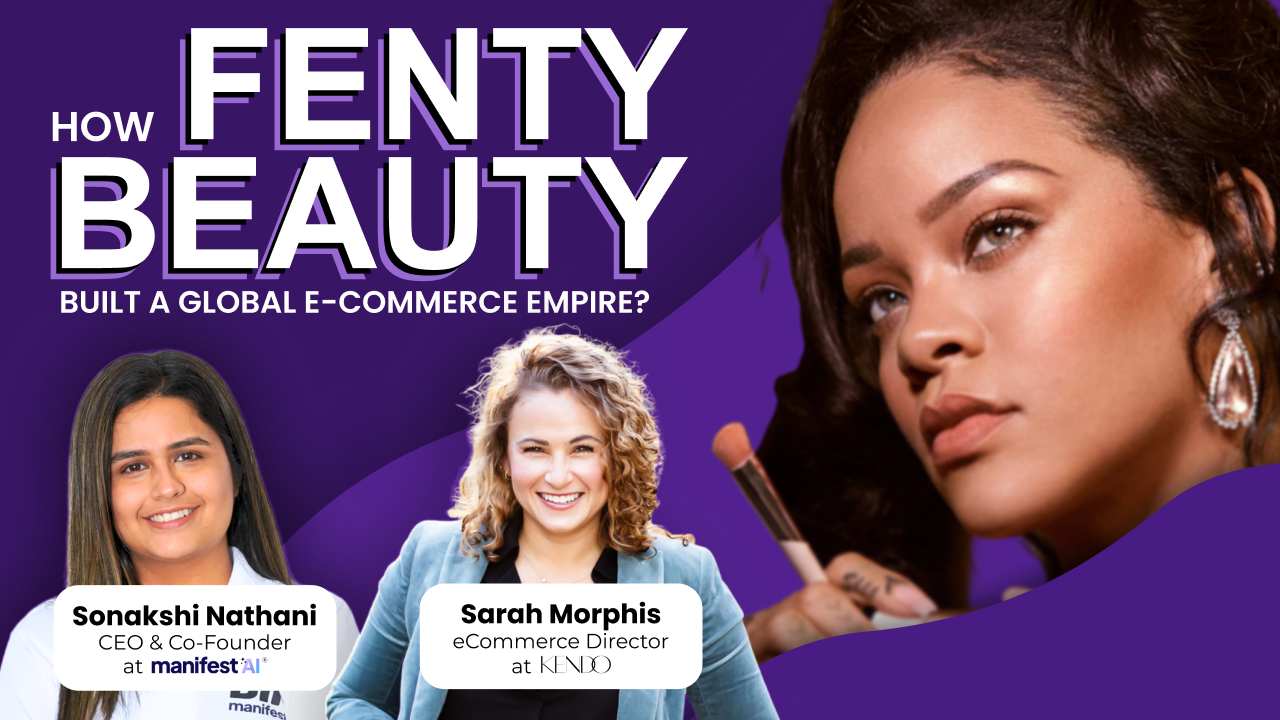LIVE AMA- How Fenty Beauty Built a Global eCommerce Empire - Featuring Kendo Brand's eComm Director

Welcome to our 8th AMA session featuring Sarah Morphis, eCommerce Director at Kendo Brands, as we dive into “How Fenty Beauty Built a Global eCommerce Empire.”
A Roaring Ladies of E-commerce AMA with Sarah Morphis, Senior Director of Digital Marketing & E-commerce at Kendo Brands
Hosted by Sonakshi Nathani, Founder & CEO of Manifest AI & Creator of RLOE
Introduction
Brief context about the AMA, the community, and what the session covered - Sarah’s six-year journey at Kendo Brands, her take on BFCM strategy, social commerce, loyalty programs, omnichannel experience, and advice for women in leadership.
About Manifest AI & RLOE
This AMA was sponsored by Manifest AI, an AI shopping-assistant platform helping e-commerce brands boost conversion and reduce support tickets. Also launched the World's first AI Commerce Agents Marketplace, a marketplace of 100+ AI agents, also a platform to build your own.
Every month, we host AMA sessions for our Roaring Ladies of eCommerce (RLOE) community, a global women’s eCommerce network of 700+ members from top brands and agencies like Glossier, Glamnetic, Liquid Death, Steve Madden, VaynerMedia, H&M, Sol de Janeiro, Sephora, and Skims.
It is one of the most active and valuable communities in the eCommerce space.
The Conversation (Q&A) between Sarah & Sonakshi
Q. What excited you to join Kendo, and how has your journey been so far?
Sarah: “Yeah, so I've been with Kendo for, it'll be 6 years in just a couple months, and it has been a wild ride. I see some Kendo Kendo Whites on the Zoom, and I'm sure they can attest to the fun adventure that we continue to have. What drew me to it—so prior to joining Kendo, I was in the food and beverage space, and I really wanted to get back into direct-to-consumer and wanted to be within a category that people feel super passionate about. And I mean, everyone loves beauty. And so I joined about 6 years ago. I joined actually leading our Marc Jacobs Beauty brand. And then my scope quickly increased and I now lead all brands at Kendo.”
Q.What has excited you the most at Kendo so far in the last six years?
Sarah: “The constant change and trying new things and test and learn, we joke internally, we're always pivoting. As much as that can be difficult, it's also really exciting. I've been drawn to the digital and e-commerce space because you can put something out into the world and get learnings and results back right away, see the impact almost immediately. Kendo has that mindset of being open to test and learn, trying new things, and that's been—while challenging—super exciting.”
Q.Since BFCM is around the corner, what strategy has worked best in the past and how will you execute this season?
Sarah: “One of the big learnings a few years ago - this seems obvious—we put some really juicy GWPs in place for Black Friday Cyber Monday, and we saw a pretty sizable increase in performance year over year. As we've evolved, the strategy this year I'm excited about is the incorporation of social commerce and how that looks now in the mix. We've got social commerce, retailer channels, and our own .com. We're laying out the plan to think through the full customer experience across all channels, consistent pricing, consistent messaging, with the goal of leveraging social commerce as a marketing vehicle to drive all other sales channels. We'll see how it goes, but we're excited.”
Q.Any particular platform leading social commerce? And have you set revenue expectations from it?
Sarah: “I think you all can imagine what the lead channel is; everyone is scrolling their FYP. As for revenue targets, I can't share exactly what those are, but they're double-digit percent of our total direct sales. It's growing—it takes a lot of work—but it's growing.”
Q.How do you see loyalty coming into play to engage current customers and acquire new ones, or penetrate unique markets?
Sarah: “Loyalty is interesting and candidly not one that we’ve fully untapped and unlocked yet at Kendo. We have subscription programs across our sites—they're doing their thing, but we haven't put the level of energy and effort into those programs as we should. It's a big initiative going into next year. We've been focused on new customer acquisition, and now we want to retain those customers. What we've seen success with is tapping into products customers are passionate about and partnering with product development and brand teams on that pipeline, exclusive fun items customers love—using those for acquisition and retention.”
Q.How does an omnichannel loyalty/retention strategy work? Say someone buys Kendo via Sephora, how do you retarget them on .com or marketplaces?
Sarah: “As I'm sure you can imagine, sharing customer data is difficult, if not impossible, and it's only gotten more difficult. There isn't a great way to retarget those customers. What we're trying to do is leverage the channels where we do have insight into the customer to help support and inform strategies and media mix for channels where we don't. We’ve tested things: when we launched in Ulta, we tested driving Ulta users to our shade-finding capability to help them find their shade even though they were in the store. We're trying to test these things out here and there.”
Q.If you were building a retention roadmap for a restorative/preventative herbal wellness brand, what frameworks or platforms would you use for dynamic personalization? First three automations or data triggers?
Sarah: “That is a really tough question. My gut is you have brands like Spoiled Child , Il Makiage, where the first touchpoint is a quiz. You unlock and understand the customer—what are they looking for, what are their concerns, those quizzes inform product recommendations and capture a ton of customer data you can feed into the overall journey. The other thing we've explored (we haven't executed yet) with one of our skincare brands: developing shade/skin finding so customers scan their face initially to get recommendations, then setting a journey to have them come back and scan in 4, 8, 12 weeks to see how the skincare products have impacted and improved their concerns. Some of this is easier; some is much more tech-intensive to integrate.”
Q.What data points should that quiz capture?
Sarah: “Skin type and time-bound life events. Target actually did this years ago, they used purchase behavior to predict pregnancy based on the six months preceding and how it shifted, then targeted messaging around preparing for a child and baby products. That was before a lot of data privacy regulations shifted, but it was brilliant. Target has a wide portfolio and a ton of customer data; they can compile a lot more data than smaller single-brand platforms can. But it's a smart way to synthesize purchase insights to inform targeting and communication.”
Q.How did you narrow the strategy to an experience that feels authentic to the Fenty brand?
Sarah: “Really embracing who we are authentically. We're a social-first brand with a very specific tone and voice. Fenty was founded on inclusivity, the first brand to launch with the most inclusive shade range, so those values are always at the forefront across all touchpoints. Sometimes, true sales-driving e-commerce initiatives have to take a backseat to keep the brand experience at the forefront. That's challenging, but we have to stay grounded in who we are. People throw around ‘authentic’ a lot, but it's really important, customers will see right through it, and they will call us out when something isn’t right.”
Q.How do you ensure reputation management supports that experience? Any AI tools for sentiment?
Sarah: “We have a very integrated and collaborative team across departments. Our social team and customer service team are at the forefront of customer interactions. We also have a field team working directly with retail teams. These three teams come together regularly to discuss what's happening, what consumers are saying, good, bad, indifferent, and we pivot and make changes to address that. We have communication channels where frontline team members call out, ‘Hey, customer said this,’ and we fix it right away.
There are social listening tools that the team uses. We recently launched an AI tool for our customer service—it's new; we're learning how it impacts the customer experience—but we can start to pull sentiment. We also leverage return data and have enhanced our returns flow to capture and share learnings. In social commerce, we can see search insights. Transparently, there was a bug earlier this year that allowed customers to purchase products very inexpensively—coupon code bundling—people figured out how to break the system and shared it everywhere on Reddit. It was about an hour, and we fixed it, but that ended up associated with our brand as one of the top search terms on social commerce, where people were sharing the hack.”
Q.For a single-product brand, a dedicated sales page or a regular website with a product page?
Sarah: “It goes down to the site experience you're trying to deliver. Putting myself in the customer's shoes, my expectation when I land on a site is that it isn’t just a single PDP—that there’s additional content and perhaps additional products. Without knowing the objectives and product, my gut recommendation is a website (not a single page) so customers can navigate. That’s what we've trained customers to do.”
Q.How can smaller brands apply these tactics on a smaller budget?
Sarah: “Smaller brands can be more agile—and that is crucial. Of course, it’s nice to have a budget, but small, nimble teams that can make their way through changes and pivot quickly are powerful. We see it at Kendo—some brands are smaller and can move quickly. The hope is that you move fast, learn, grow the business, and unlock more dollars. A lot of change in this space is actually set up for smaller, agile teams, even with fewer resources. I'm also a firm believer that sometimes the juice isn’t worth the squeeze; some things just need to be dropped. Focus. Smaller brands can sometimes make those tough choices more easily than bigger brands.”
Q.One piece of advice for women building their careers in e-commerce?
Sarah: “I had a mentor at Gallo who really helped me find my voice. It was so impactful on my career and something I share with my team all the time. I want to hear from people. I want your opinion, your perspective, what you think. Anyone can do the job—hands-on keys, merchandise a site, manage a site, but it's the thinking and vocalizing what you're thinking that sets us apart as individuals. Speak up. Ask questions. Share your perspective. Have an opinion, have a voice—it's really powerful.”
If you want to watch the full AMA video, here it is:

.png)
